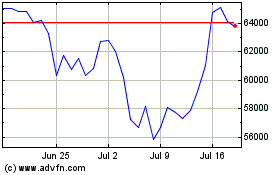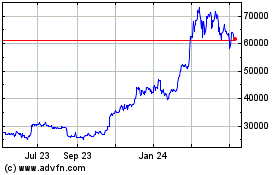Bitcoin Hash Ribbons Form Capitulation Signal: What It Means
May 15 2024 - 12:00PM
NEWSBTC
On-chain data shows the Bitcoin Hash Ribbons have recently gone
through a crossover. Here’s what it could mean for the
cryptocurrency. Bitcoin Hash Ribbons Suggest Miner Capitulation Is
On As explained by CryptoQuant community manager Maartunn in a
Quicktake post, miners are capitulating right now if the Hash
Ribbons indicator is to be believed. This on-chain metric is
generally used to determine whether miners are in distress. BTC
runs on a proof-of-work (PoW) consensus mechanism where miners play
the role of validators and compete against each other using
computing power to get a chance to add the next block to the chain.
This computing power, when measured across the network, can provide
insight into the health of the miners as a whole. Due to this
reason, the Hash Ribbons indicator makes use of this total Bitcoin
“Hashrate” to judge the situation of the miners. Related Reading:
Bitcoin Price Linked To Binance Vs Coinbase Battle, Quant Reveals
Naturally, a rise in the Hashrate suggests the network is
attracting miners right now, while a decline could imply low
profitability is making some of these validators pull out from BTC.
The Hash Ribbons indicator uses two moving averages (MA) of the
Hashrate, 30-day and 60-day, to represent whether these behaviors
are particularly intense or not at the moment. When the 30-day
ribbon moves under the 60-day one, it suggests that miners are mass
capitulating. On the other hand, the opposite cross suggests
network is observing growth again. Now, what relevance do these
trends have for Bitcoin? According to Charles Edwards, the creator
of the Hash Ribbons, the miners have historically been quite
resilient, and they only quit when things get especially bad for
the cryptocurrency. As such, the market may be more likely to
approach a bottom whenever these chain validators show
capitulation. Below is a chart that shows how the miners’ behaviour
has looked recently according to this indicator: As Maartunn has
highlighted in the graph, the Bitcoin Hash Ribbons have seen a
crossover recently. More specifically, the cross has involved the
30-day moving under the 60-day, implying that the miners are
capitulating. Miner profits come down to three factors: BTC spot
price, transaction fees, and electricity costs in the area that
they are located in. Historically, the fees has been quite low in
comparison to the block rewards, so miner financials have been
dependent on the price (as the block rewards only have this
variable attached to them) and electricity prices. Recently, the
BTC price has been stuck in consolidation while the block rewards
have been slashed in half in the latest Halving event. This has led
to tightening revenues for these chain validators, so it’s not
surprising to see that the miners with the least efficient machines
have already started ditching the network in hordes. Related
Reading: Newbie Bitcoin Whales Buying 200,000 BTC Per Week, Data
Shows In the chart, past instances of miner capitulation are shown
with the green lines. It’s visible that while miner capitulation
has generally indeed occurred near profitable buying points into
the asset, these bottoms haven’t immediately appeared after the
crossovers have occurred. As the analyst notes, “It unfolds in the
subsequent days and weeks after less efficient miners throw in the
towel.” BTC Price Bitcoin has continued to move overall flat over
the past week as its price is still trading around $62,700.
Featured image from Vasilis Chatzopoulos on Unsplash.com,
CryptoQuant.com, chart from TradingView.com
Bitcoin (COIN:BTCUSD)
Historical Stock Chart
From Apr 2024 to May 2024

Bitcoin (COIN:BTCUSD)
Historical Stock Chart
From May 2023 to May 2024
